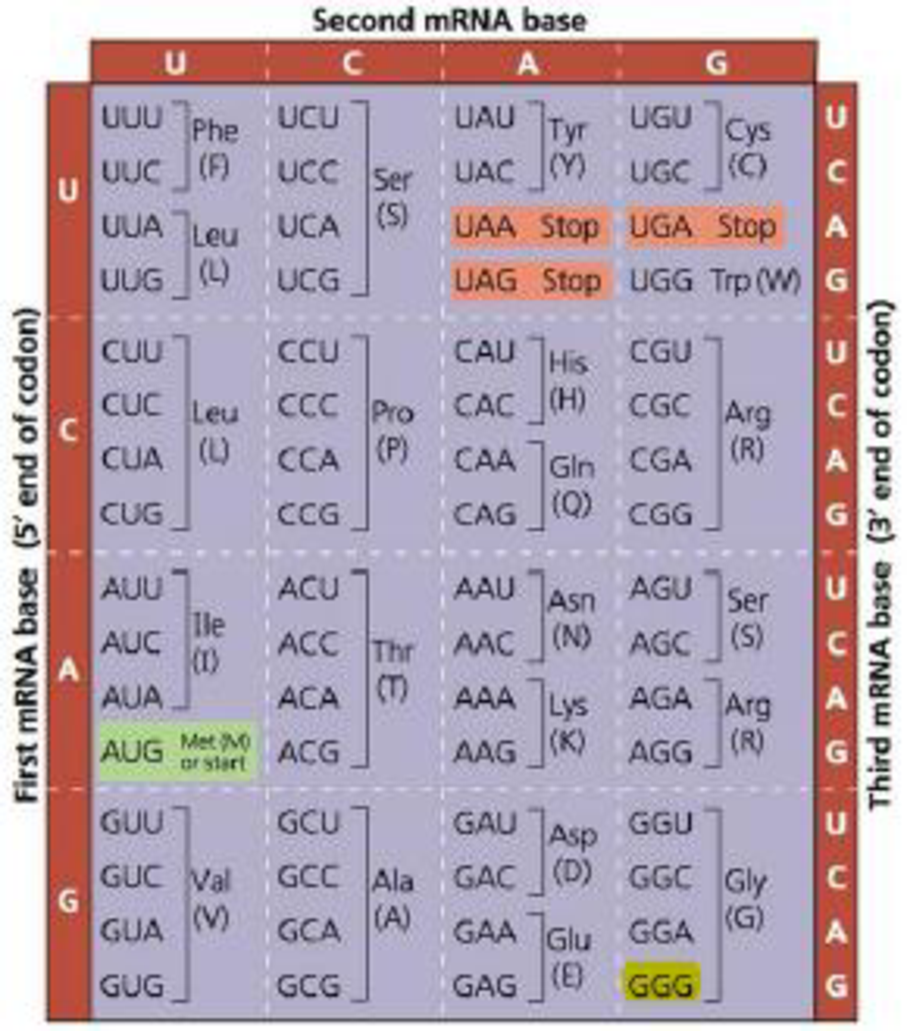
Concept explainers
- a. In what three ways does RNA differ from DNA?
- b. Fill in the following sequence in the flow of genetic information, often called the central dogma. Above each arrow, write the name of the process involved.
Figure 17.6 The codon table for mRNA. The three

VISUAL SKILLS A segment in the middle of an mRNA has the sequence 5′-AGAGAACCGCGA-3′. Using the codon table, translate this sequence, assuming the first three nucleotides are a codon.
a.
To determine: Three ways in which ribonucleic acid (RNA) differs from deoxyribonucleic acid (DNA).
Introduction: Nucleic acids are the major organic molecules of all living organisms. Nucleic acids are made of three major components, such as nitrogenous base, pentose sugar, and phosphate group. The two major nucleic acids are deoxyribonucleic acid (DNA) and ribonucleic acid (RNA). DNA carries the genetic information from one generation to other generation. DNA controls the synthesis of RNA in the cell. RNA is responsible for the synthesis of protein molecules.
Explanation of Solution
Three ways in which DNA differ from RNA are given below:
| Criteria | DNA | RNA |
| Pentose sugar | DNA contains deoxyribose pentose sugar. | RNA contains ribose pentose sugar. |
| Nitrogenous base | DNA has 4 nitrogenous bases, namely adenine, cytosine, guanine, and thiamine. | RNA has 4 nitrogenous bases, namely adenine, cytosine, guanine, and uracil. |
| Strand | DNA is double-stranded. | RNA is single-stranded. |
b.
To fill and name: The given sequence in the flow of genetic information and the process involved in it.
Introduction: The central dogma of biology explains the flow of information from genes to protein by two processes. These two processes are transcription and translation.
Explanation of Solution
The given sequence in the flow of genetic information and the process involved in it is as follows:
Transcription is a process in which a DNA sequence is converted into a functional piece of RNA. In the initiation of transcription, RNA polymerase binds to the sequence of DNA, and then the unbinding of DNA strand takes place. RNA polymerase adds the RNA bases to the DNA that creates a single strand of mRNA. RNA polymerase detaches from the sequence, and the newly formed sequence of mRNA is released into the nuclear fluid, and then it leaves the nucleus.
After the transcription, the newly formed mRNA enters the cytosol. In the cytosol, processed mRNA associates with many ribosomes. The complex of ribosome-mRNA starts the process of translation. At the initiation of translation, anticodons that appear on tRNA attaches with the mRNA codon. This attachment of tRNA and mRNA codon corrects the orientation of newly arrived amino acids. These amino acids are linked together by a peptide bond, and a peptide chain starts to grow.
Transcription is the formation of RNA from a DNA sequence and through the process of translation, protein is formed from the RNA.
Want to see more full solutions like this?
Chapter 17 Solutions
Study Guide for Campbell Biology
- What is the opening indicated by the pointer? (leaf x.s.) stomate guard cell lenticel intercellular space none of thesearrow_forwardIdentify the indicated tissue? (stem x.s.) parenchyma collenchyma sclerenchyma ○ xylem ○ phloem none of thesearrow_forwardWhere did this structure originate from? (Salix branch root) epidermis cortex endodermis pericycle vascular cylinderarrow_forward
- Identify the indicated tissue. (Tilia stem x.s.) parenchyma collenchyma sclerenchyma xylem phloem none of thesearrow_forwardIdentify the indicated structure. (Cucurbita stem l.s.) pit lenticel stomate tendril none of thesearrow_forwardIdentify the specific cell? (Zebrina leaf peel) vessel element sieve element companion cell tracheid guard cell subsidiary cell none of thesearrow_forward
- What type of cells flank the opening on either side? (leaf x.s.) vessel elements sieve elements companion cells tracheids guard cells none of thesearrow_forwardWhat specific cell is indicated. (Cucurbita stem I.s.) vessel element sieve element O companion cell tracheid guard cell none of thesearrow_forwardWhat specific cell is indicated? (Aristolochia stem x.s.) vessel element sieve element ○ companion cell O O O O O tracheid O guard cell none of thesearrow_forward
- Identify the tissue. parenchyma collenchyma sclerenchyma ○ xylem O phloem O none of thesearrow_forwardPlease answer q3arrow_forwardRespond to the following in a minimum of 175 words: How might CRISPR-Cas 9 be used in research or, eventually, therapeutically in patients? What are some potential ethical issues associated with using this technology? Do the advantages of using this technology outweigh the disadvantages (or vice versa)? Explain your position.arrow_forward
 Biology (MindTap Course List)BiologyISBN:9781337392938Author:Eldra Solomon, Charles Martin, Diana W. Martin, Linda R. BergPublisher:Cengage Learning
Biology (MindTap Course List)BiologyISBN:9781337392938Author:Eldra Solomon, Charles Martin, Diana W. Martin, Linda R. BergPublisher:Cengage Learning Human Heredity: Principles and Issues (MindTap Co...BiologyISBN:9781305251052Author:Michael CummingsPublisher:Cengage Learning
Human Heredity: Principles and Issues (MindTap Co...BiologyISBN:9781305251052Author:Michael CummingsPublisher:Cengage Learning Biology Today and Tomorrow without Physiology (Mi...BiologyISBN:9781305117396Author:Cecie Starr, Christine Evers, Lisa StarrPublisher:Cengage Learning
Biology Today and Tomorrow without Physiology (Mi...BiologyISBN:9781305117396Author:Cecie Starr, Christine Evers, Lisa StarrPublisher:Cengage Learning
 BiochemistryBiochemistryISBN:9781305577206Author:Reginald H. Garrett, Charles M. GrishamPublisher:Cengage Learning
BiochemistryBiochemistryISBN:9781305577206Author:Reginald H. Garrett, Charles M. GrishamPublisher:Cengage Learning Biology 2eBiologyISBN:9781947172517Author:Matthew Douglas, Jung Choi, Mary Ann ClarkPublisher:OpenStax
Biology 2eBiologyISBN:9781947172517Author:Matthew Douglas, Jung Choi, Mary Ann ClarkPublisher:OpenStax





